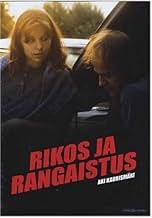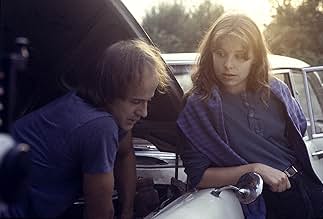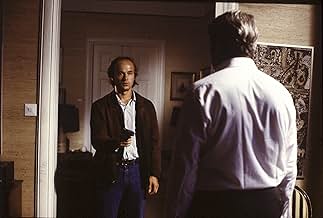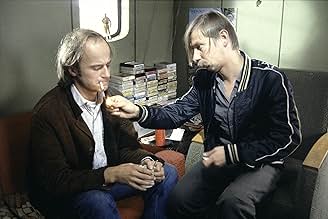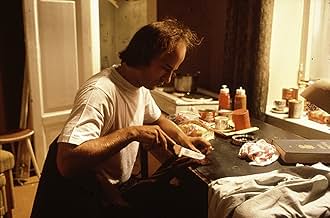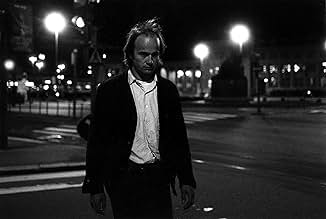IMDb-BEWERTUNG
7,0/10
3357
IHRE BEWERTUNG
Füge eine Handlung in deiner Sprache hinzuA slaughterhouse worker and former law student, takes vengeance on the man who killed his fiancée in a hit and run accident.A slaughterhouse worker and former law student, takes vengeance on the man who killed his fiancée in a hit and run accident.A slaughterhouse worker and former law student, takes vengeance on the man who killed his fiancée in a hit and run accident.
- Auszeichnungen
- 2 Gewinne & 1 Nominierung insgesamt
Pedro Hietanen
- Pianist
- (as Pedro's Heavy Gentleman)
Hannu Lemola
- Drummer
- (as Pedro's Heavy Gentleman)
Heljä Angervo-Karttunen
- Opera Singer
- (Nicht genannt)
Juuso Hirvikangas
- Man at the Police Station
- (Nicht genannt)
Jorma Hynninen
- Opera Singer
- (Nicht genannt)
Handlung
WUSSTEST DU SCHON:
- WissenswertesAki Kaurismäki's narrative directorial debut. He chose this project after reading François Truffaut's interview with Alfred Hitchcock, where Hitchcock claimed Crime and Punishment was the one book he would never adapt, because "it would be too difficult." Kaurismäki later admitted it was too difficult.
- Zitate
Antti Rahikainen: [to Eeva Laakso] I'll tell you something. The man I killed is not important. I killed a louse, and became one myself. The number of lice remained constant. Unless I was one from the very beginning - but that's not important. I wanted to kill a principle, not a man.
- VerbindungenFeatured in Selección TCM: Aki Kaurismaki (2012)
- SoundtracksCadillac
Written by Kim Brown, Denys Gibson, Ian Mallet, Stuart Graham Johnson and Vince Taylor
Performed by The Renegades
Ausgewählte Rezension
This adaptation of Fyodor Dostoevsky's novel "Crime and Punishment" was Finnish director Aki Kaurismäki's first film, and it shows. Later, one of his pictures ("The Man Without a Past" (2003)) would be nominated for a Best Foreign-Language Film Oscar, but this initial effort is amateurish. Not technically, that is, but its transmutation from page to screen is prosaic and oblivious to the stylistic and thematic qualities of the book and how to translate them cinematically. I've sought out two dozen movies inspired by Dostoevsky's tale now since reading it, and although this is hardly the worst, it's in some ways the most daft and pointless.
As with many bad adaptations, it's chiefly concerned with story, and Kaurismäki and his co-screenwriter actually do a rather good job at condensing a vast novel into about an hour-and-a-half runtime. The characters are reduced to four main ones, with the Sonya type taking on qualities of one of the murder victims in the source, as well as of Raskolnikov's sister. The Svidrigaïlov type likewise assumes the part of another of Dostoevsky's characters to accuse Raskolnikov or murder. Similar to the 1935 American version, this character is also shoehorned into the traditional function of a heavy instead of the rather amusing rapscallion he was in prose. Meanwhile, the Sonya isn't a religious hooker with a heart of gold, and Raskolnikov isn't a writer whose murder is an expression of his philosiphizing.
I'm especially displeased that the film does away with this self-referential device of a surrogate author within the story (see Robert Bresson's "Pickpocket" (1959) for how this framework can be quite fruitful). Moreover, Kaurismäki fails to replace the religious and philosophical dialogues of Dostoevsky's work absent here with anything interesting. He begins with his Raskolnikov working in a meat-packing plant, but does nothing to suggest any link between the cutting of flesh and his subsequent murder of a man. In fact, the film changes the murder from being done with an axe in the novel to, here, performed with a gun. I mean, talk about blowing a perfectly good opportunity for a visual motif of cutting bodies apart! This is what I mean by "amateurish." Simple opportunities are wasted, and nothing compelling is put in their place.
The relatively-deadpan acting, or otherwise apparent lack of emotional conveyance, is another odd choice here for being based on an intense book for which the god-like, omnipresent narration looked into the thoughts of its characters. Here, we can't even read the actors' faces and body language because they're so expressionless. The protagonist, at least, conveys an occasional wry sense of humor. This is a rare version that actually shows the Raskolnikov with a slight smile in his climactic look with the Sonya as he discovers she's followed him. But, for the most part, his behavior merely seems erratic. The actress playing the Sonya is worse--I think it's just a bad performance. The police inspector here is another character who could be jovial and witty in prose, but is purely a bore on screen. Again, Bresson worked better with affectless amateur actors in "Pickpocket," and he employed voiceover narration in addition to the surrogate author device to get inside the mind of the protagonist. The 1923 silent German version also reflected Raskolnikov's inner torment well by representing it in the Expressionist set design.
Some of the scenes that Kaurismäki decided to linger on are equally perplexing. Besides the butchering episode, for example, I fail to see the interest of watching the sexist Inspector inform his wife when she's allowed to go to bed, nor why the film spends time watching him drink alcohol. Indeed, there are a few pointless scenes in this one of characters drinking. Although not as bad as another adaptation, "Norte: the End of History" (2013), in this respect and others, it's still flummoxing. When Dostoevsky's characters drank, there were reasons, and they tended to go on at length as to what they were. Too much time is spent on the filmmakers' apparent interest in English-language mood music, as well. Moreover, it's hard to discern what the point of this adaptation was at all. If it were to inhabit Helsinki, then show the city. This is based on a book where the main character repetitively wandered the streets of Saint Petersburg until it becomes almost familiar to even a reader who's never been (and certainly never in Dostoevsky's time). We don't get that here; another opportunity squandered as the film's protagonist talks more about lonely walks than we actually see him doing it. We inhabit, however, parts of Bresson's Paris, or, heck, even that of the entirely artificial settings of the 1923 picture. As much as I dislike "Norte," it does, at least, explore its Filipino locales better than this Finnish counterpart. And, to conclude, this Raskolnikov claims that he's always been alone; yet, we hardly ever see him alone in this picture. Even the one time he drives off by his lonesome, he immediately turns back around. From the first to last scene, he's usually surrounded by people, and he forms intimate relationships with at least two of them. Without demonstrating the statement, to leave it by itself is trite.
This is a blunder of a first film. There's no apparent understanding of the source text, nor a coherent vision of what to make of it. It's not an impossible novel to adapt. Bresson arguably made a masterpiece out of it, Robert Wiene did well in the silent era, the 1935 French version at least rendered the story and acting well--heck, Woody Allen has attacked it thrice now. But, that this Finnish one isn't even the worst tells you that others (and by rather well-respected filmmakers, to boot, including twice-Oscar-nominated Josef von Sternberg (1935), "Russian Ark" (2002) director Aleksandr Sokurov (1994) and slow-cinema arthouse filmmaker Lav Diaz (2013)) have failed, too.
As with many bad adaptations, it's chiefly concerned with story, and Kaurismäki and his co-screenwriter actually do a rather good job at condensing a vast novel into about an hour-and-a-half runtime. The characters are reduced to four main ones, with the Sonya type taking on qualities of one of the murder victims in the source, as well as of Raskolnikov's sister. The Svidrigaïlov type likewise assumes the part of another of Dostoevsky's characters to accuse Raskolnikov or murder. Similar to the 1935 American version, this character is also shoehorned into the traditional function of a heavy instead of the rather amusing rapscallion he was in prose. Meanwhile, the Sonya isn't a religious hooker with a heart of gold, and Raskolnikov isn't a writer whose murder is an expression of his philosiphizing.
I'm especially displeased that the film does away with this self-referential device of a surrogate author within the story (see Robert Bresson's "Pickpocket" (1959) for how this framework can be quite fruitful). Moreover, Kaurismäki fails to replace the religious and philosophical dialogues of Dostoevsky's work absent here with anything interesting. He begins with his Raskolnikov working in a meat-packing plant, but does nothing to suggest any link between the cutting of flesh and his subsequent murder of a man. In fact, the film changes the murder from being done with an axe in the novel to, here, performed with a gun. I mean, talk about blowing a perfectly good opportunity for a visual motif of cutting bodies apart! This is what I mean by "amateurish." Simple opportunities are wasted, and nothing compelling is put in their place.
The relatively-deadpan acting, or otherwise apparent lack of emotional conveyance, is another odd choice here for being based on an intense book for which the god-like, omnipresent narration looked into the thoughts of its characters. Here, we can't even read the actors' faces and body language because they're so expressionless. The protagonist, at least, conveys an occasional wry sense of humor. This is a rare version that actually shows the Raskolnikov with a slight smile in his climactic look with the Sonya as he discovers she's followed him. But, for the most part, his behavior merely seems erratic. The actress playing the Sonya is worse--I think it's just a bad performance. The police inspector here is another character who could be jovial and witty in prose, but is purely a bore on screen. Again, Bresson worked better with affectless amateur actors in "Pickpocket," and he employed voiceover narration in addition to the surrogate author device to get inside the mind of the protagonist. The 1923 silent German version also reflected Raskolnikov's inner torment well by representing it in the Expressionist set design.
Some of the scenes that Kaurismäki decided to linger on are equally perplexing. Besides the butchering episode, for example, I fail to see the interest of watching the sexist Inspector inform his wife when she's allowed to go to bed, nor why the film spends time watching him drink alcohol. Indeed, there are a few pointless scenes in this one of characters drinking. Although not as bad as another adaptation, "Norte: the End of History" (2013), in this respect and others, it's still flummoxing. When Dostoevsky's characters drank, there were reasons, and they tended to go on at length as to what they were. Too much time is spent on the filmmakers' apparent interest in English-language mood music, as well. Moreover, it's hard to discern what the point of this adaptation was at all. If it were to inhabit Helsinki, then show the city. This is based on a book where the main character repetitively wandered the streets of Saint Petersburg until it becomes almost familiar to even a reader who's never been (and certainly never in Dostoevsky's time). We don't get that here; another opportunity squandered as the film's protagonist talks more about lonely walks than we actually see him doing it. We inhabit, however, parts of Bresson's Paris, or, heck, even that of the entirely artificial settings of the 1923 picture. As much as I dislike "Norte," it does, at least, explore its Filipino locales better than this Finnish counterpart. And, to conclude, this Raskolnikov claims that he's always been alone; yet, we hardly ever see him alone in this picture. Even the one time he drives off by his lonesome, he immediately turns back around. From the first to last scene, he's usually surrounded by people, and he forms intimate relationships with at least two of them. Without demonstrating the statement, to leave it by itself is trite.
This is a blunder of a first film. There's no apparent understanding of the source text, nor a coherent vision of what to make of it. It's not an impossible novel to adapt. Bresson arguably made a masterpiece out of it, Robert Wiene did well in the silent era, the 1935 French version at least rendered the story and acting well--heck, Woody Allen has attacked it thrice now. But, that this Finnish one isn't even the worst tells you that others (and by rather well-respected filmmakers, to boot, including twice-Oscar-nominated Josef von Sternberg (1935), "Russian Ark" (2002) director Aleksandr Sokurov (1994) and slow-cinema arthouse filmmaker Lav Diaz (2013)) have failed, too.
- Cineanalyst
- 25. Sept. 2019
- Permalink
Top-Auswahl
Melde dich zum Bewerten an und greife auf die Watchlist für personalisierte Empfehlungen zu.
- How long is Crime and Punishment?Powered by Alexa
Details
- Erscheinungsdatum
- Herkunftsland
- Offizieller Standort
- Sprache
- Auch bekannt als
- Crime and Punishment
- Drehorte
- Produktionsfirma
- Weitere beteiligte Unternehmen bei IMDbPro anzeigen
Box Office
- Budget
- 1.726.378 FIM (geschätzt)
Zu dieser Seite beitragen
Bearbeitung vorschlagen oder fehlenden Inhalt hinzufügen

Oberste Lücke
By what name was Schuld und Sühne (1983) officially released in India in English?
Antwort
